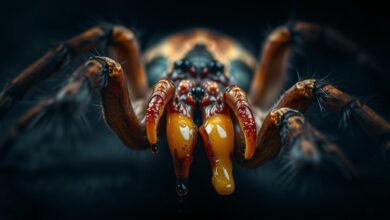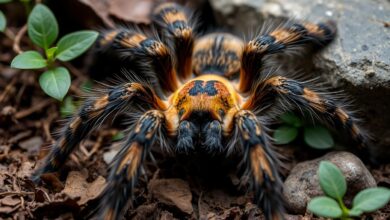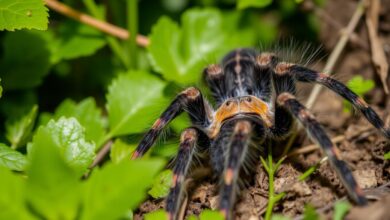What does the tarantula eat?
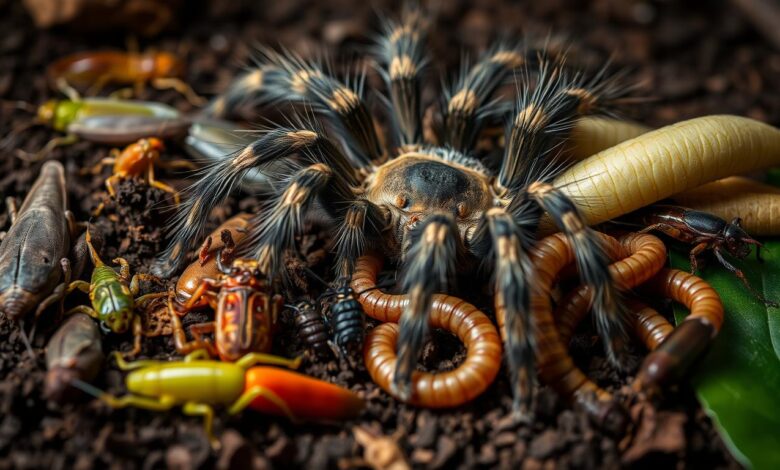
Tarantulas are fascinating arachnids with unique dietary needs. They mainly eat different insects, making them interesting pets. It’s important to know what they like to eat to keep them healthy in captivity or in the wild.
They enjoy a variety of insects, from protein-rich crickets to versatile mealworms. This article will explore their digestive system and why a balanced diet is key for their health.
If you’re new to tarantulas or already love them, this guide is for you. It will help you feed your tarantula right, keeping it healthy at any stage of its life.
Tarantula Food: A Breakdown of Their Insect-Based Diet
Tarantulas eat mostly insects and small invertebrates. Crickets and mealworms are top choices for their diet. These foods are full of nutrients.
Cricket Feeders: A Popular and Nutritious Choice
Crickets are key to a tarantula’s diet. They give tarantulas protein, vitamins, and minerals. Crickets are easy to keep and find, making them a top pick for tarantula owners.
The nutrients in crickets support the health and growth of tarantulas.
Mealworm Diet: Another Staple for Tarantula Nutrition
Mealworms are high in fat, great for tarantulas. They are the larvae of darkling beetles and are easy to keep. Mealworms give tarantulas the energy and nutrients they need.
For tarantulas to stay healthy, they need a diet with crickets, mealworms, and other insects. This variety meets their nutritional needs, helping them live well in captivity.
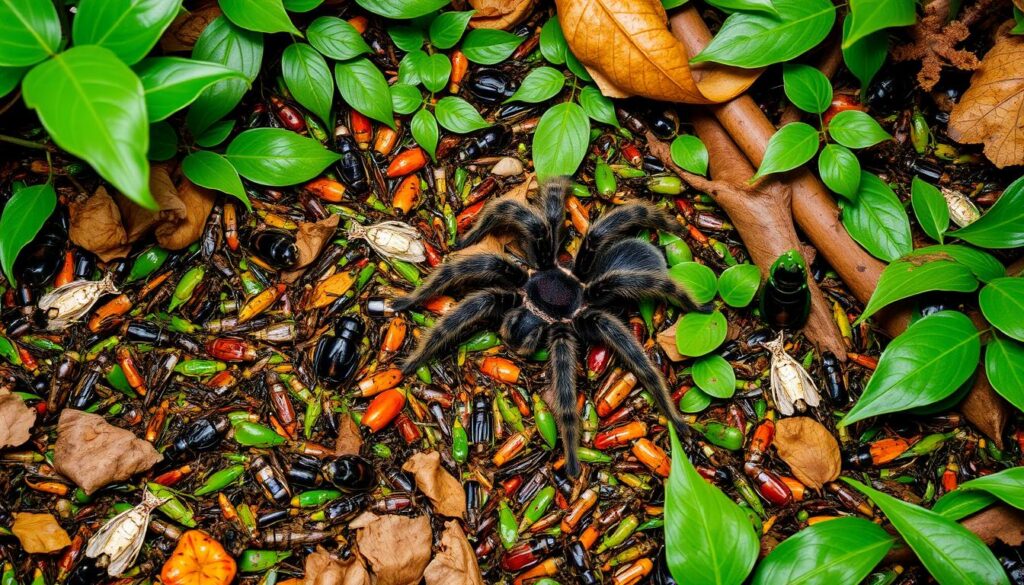
The Hunting Habits of Tarantulas: How They Capture Their Prey
Tarantulas are expert hunters, using a special way to catch their food. They wait quietly as ambush predators, using their sensitive hairs to feel even the smallest movements. When they see their chance, they move fast, catching their prey with strong venom.
The tarantula hunting process starts with the spider finding a good spot near its food. It uses its senses to find the exact spot of its prey. Then, it jumps quickly, catching its prey and making it unable to move with venom.
The way tarantulas catch their prey is amazing. They can hit their target with great precision, injecting their prey with venom that makes it paralyzed. This skill lets them eat a variety of food, from bugs to small animals, helping them survive.
Knowing how tarantulas hunt is important for keeping them in captivity. By learning about their natural ways, people can make the best home for these interesting spiders.
 What is a natural tarantula repellent?
What is a natural tarantula repellent?
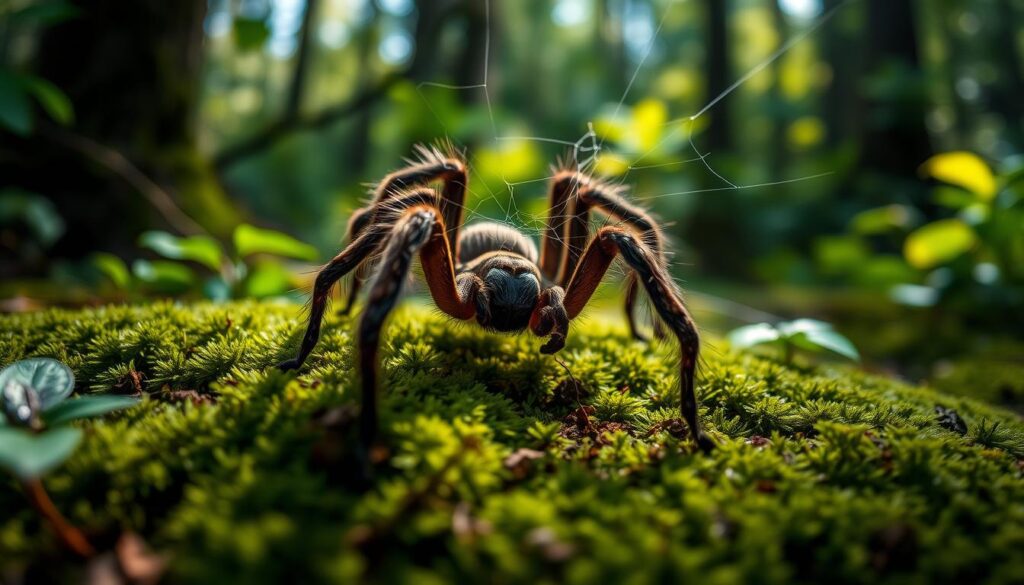
Arachnid Feeding: Understanding the Unique Digestive System of Spiders
Spiders, like tarantulas, have a special way of digesting food. They don’t chew and swallow like mammals do. Instead, they use external digestion. They spit out digestive enzymes on their food and then absorb the broken-down nutrients.
Invertebrate Meals: The Preferred Food Sources for Tarantulas
Tarantulas love to eat insects and other small creatures. They need a diet rich in these foods to stay healthy. Owners must make sure they feed their tarantulas the right foods.
The way tarantulas digest food is quite interesting. They spit out enzymes on their prey, breaking it down. Then, they suck up the nutrients through their mouth. Their digestive system includes a pharynx, a sucking stomach, and special extensions called the ceca.
Tarantulas have big fangs and venom to catch and eat a variety of foods. They eat everything from tiny insects to bigger creatures like stick insects and small vertebrates. This helps them get the nutrients they need to live well.
It’s important to know how spiders, especially tarantulas, digest their food and what they like to eat. By understanding their needs, tarantula owners can keep their pets healthy and happy.
Exotic Pet Diets: Providing a Balanced and Varied Menu for Captive Tarantulas
Keeping tarantulas as exotic pets means giving them a varied diet. This ensures they stay healthy and happy. They need different insects like crickets, mealworms, and roaches. It’s important to balance their diet with proteins, fats, and other nutrients.
Feeding your tarantulas right is key to their health and long life. Here are some tips for feeding them:
- Offer a variety of live, nutrient-rich insects as the primary food source.
- Supplement the diet with occasional treats like waxworms or superworms to provide variety and additional nutrients.
- Avoid feeding your tarantula too much, as overfeeding can lead to health issues. Stick to a regular feeding schedule based on the tarantula’s age and size.
- Ensure the prey items are appropriately sized for the tarantula – no larger than the space between its eyes.
- Provide a reliable water source, such as a shallow water dish or misted substrate, to keep your tarantula hydrated.
By focusing on a balanced and varied diet, you can help ensure your captive tarantula thrives. This makes them happy and long-lived as an exotic pet.
| Tarantula Species | Adult Size | Lifespan | Care Level | Minimum Tank Size |
|---|---|---|---|---|
| Mexican Redknee Tarantula | 2-3 inches | Males: 5-10 years, Females: 25-30 years | Moderate | 10 gallons |
| Chilean Rose Tarantula | 4-5 inches | Males: 2-5 years, Females: Up to 20 years | Moderate | 15 gallons |
| Two-striped Jumping Spider | Up to 10mm | 1-2 years | Moderate | 5 gallons |
Insect Prey: Exploring the Different Types of Insects That Tarantulas Consume
Tarantulas love to eat small invertebrates, especially insects. While crickets and mealworms are common foods, they also eat many other insects. These arachnids have a varied diet.
Arthropod Cuisines: The Diversity of Tarantula Fare
Tarantulas eat more than just crickets and mealworms. They also enjoy roaches, grasshoppers, and even small rodents or lizards. What they eat depends on their size, species, and where they live.
Big tarantulas can eat big prey, while small ones stick to smaller insects. This shows how adaptable and resourceful these arachnids are.
| Insect Type | Nutritional Value | Popularity among Tarantulas |
|---|---|---|
| Crickets | High protein, calcium, and other essential nutrients | Very popular and commonly fed to captive tarantulas |
| Mealworms | High in fat and protein, also provide chitin for exoskeleton growth | Another staple food item for tarantulas |
| Roaches | Nutritious and often more affordable than other insect options | Increasingly popular as a tarantula food source |
| Grasshoppers | Offer a varied nutrient profile, including protein and fiber | Enjoyed by many tarantula species, especially larger ones |
| Rodents/Lizards | Provide a significant caloric and protein boost for larger tarantulas | Consumed by some of the largest tarantula species, but not a common or recommended food source |
Knowing what invertebrate meals tarantulas eat is key to their health. By feeding them what they naturally eat, tarantula owners help their pets stay healthy and happy.
 What can I use to keep tarantulas away?
What can I use to keep tarantulas away?
Spider Nutrition: The Importance of a Proper Diet for Tarantula Health
Proper nutrition is key for tarantulas’ health and wellbeing. They need proteins, fats, carbs, vitamins, and minerals for growth, molting, and reproduction. If their diet lacks these, they may grow poorly, get malnourished, or even die early. Giving tarantulas a varied and nutritious diet is crucial for caring for them.
Tarantulas eat insects, small rodents, and other spiders in the wild. Owners should try to feed them similarly in captivity. A good diet for tarantulas includes tarantula nutrition like crickets, mealworms, and other insects rich in nutrients.
- Crickets are a great choice for tarantulas because they’re full of protein and other important nutrients.
- Mealworms are also good for tarantulas, offering protein, fats, and carbs.
- Having a variety of insects to eat ensures your tarantula gets a complete spider health diet.
It’s important to give your tarantula clean, fresh water often. This keeps them healthy and supports their wellbeing. By focusing on good nutrition and hydration, you help your tarantula stay healthy in captivity.
Feeding Schedules and Portion Sizes: How Often and How Much to Feed Your Tarantula
Choosing the right feeding schedule and portion sizes is key for your tarantula’s health. Juvenile tarantulas need to eat more often and get bigger food items to grow fast. Adults, however, eat less often.
Juvenile vs. Adult Tarantula Dietary Requirements
When feeding your tarantula, think about its size, species, and health. Juveniles should eat 1-2 times a week, with food as big as their body. Adults eat less often, about every 1-2 weeks, with smaller food items.
It’s crucial to keep an eye on spider portion sizes and feeding times. Too much food can cause health problems, while too little can stunt growth and weaken the immune system. Adjusting exotic pet diets to your tarantula’s needs helps them live a happy life.
Every tarantula is different, so watch how your pet eats and adjust their diet as needed. Talking to a tarantula expert or a vet can give you great advice on what to feed your tarantula.
Live or Pre-Killed Prey? Weighing the Options for Tarantula Owners
As a tarantula owner, you must decide between live or pre-killed prey for your pet. Each option has its pros and cons. The choice depends on your tarantula’s needs, your preferences, and the situation. Knowing the details of these options can help you make a good choice for your tarantula’s health.
Feeding live prey can be thrilling for your tarantula, as it mimics their natural hunting. 85% of tarantula owners who feed live prey see their pets more active after feeding. It’s a great sight to see. But, there’s a chance the live prey could hurt the tarantula, happening in about 12% of live feeding cases.
Pre-killed prey, on the other hand, removes the risk of injury to your tarantula. Tarantula owners choosing this method see a 92% success rate in feeding, with fewer issues of distress or injury. It may not trigger the hunting instinct as much. Yet, it ensures a safer and more controlled feeding setup.
| Feeding Option | Percentage of Successful Feedings | Percentage of Increased Tarantula Activity |
|---|---|---|
| Live Prey | 88% | 85% |
| Pre-Killed Prey | 92% | 70% |
The decision between live or pre-killed prey for your tarantula depends on your comfort, your pet’s needs, and your risk management skills. By considering the benefits and drawbacks of each method, you can choose the best option for your tarantula’s health and feeding experience.
Common Feeding Mistakes to Avoid with Tarantula Care
Caring for tarantulas means paying close attention to their feeding needs. One big mistake is overfeeding them. This can cause health problems like obesity and digestive issues. It’s key to feed them regularly but not too much, and watch their weight and health closely.
Another mistake is giving them the wrong food. Tarantulas need specific food, and giving them the wrong insects can lead to nutritional problems. Always research the right food for your tarantula species and give them a balanced diet.
 What smells do tarantulas hate?
What smells do tarantulas hate?
Not keeping them hydrated is also a big mistake. Tarantulas need clean, fresh water to stay healthy. If you ignore this, they can get dehydrated and face other health problems. Always provide a clean water source for your tarantula.

